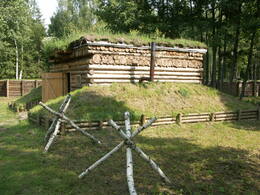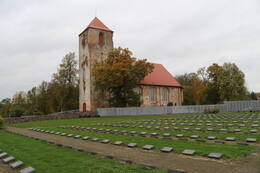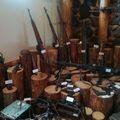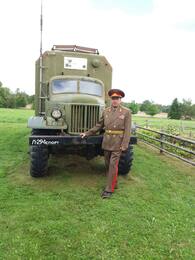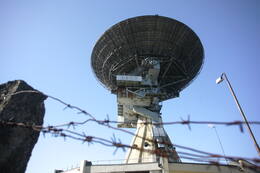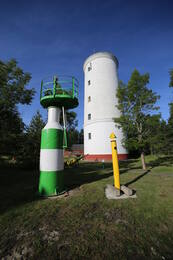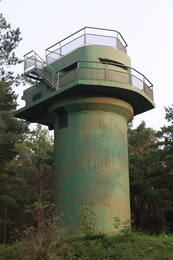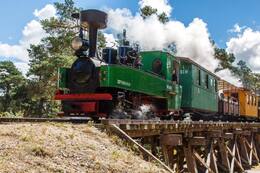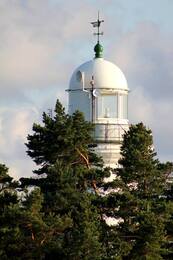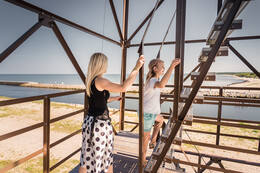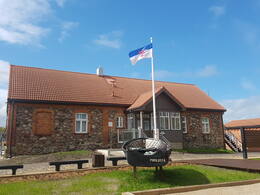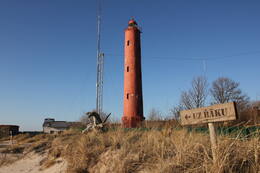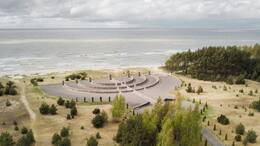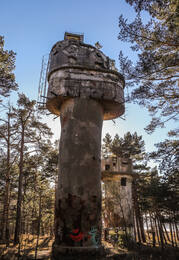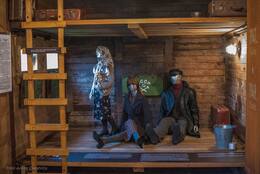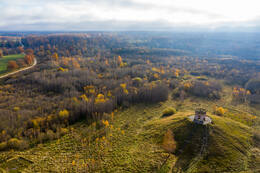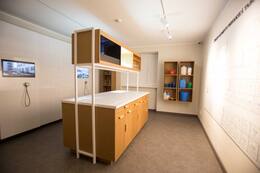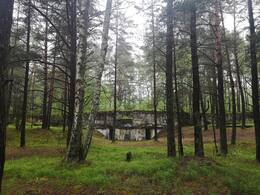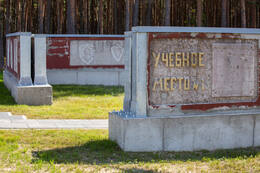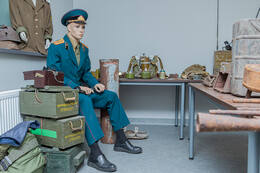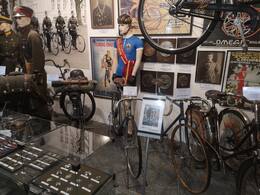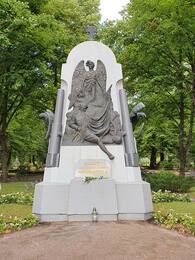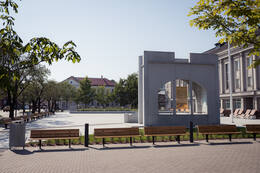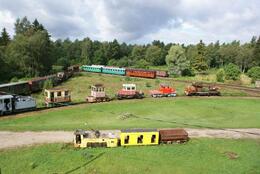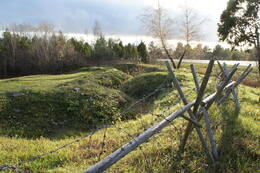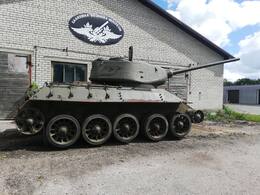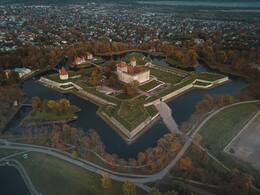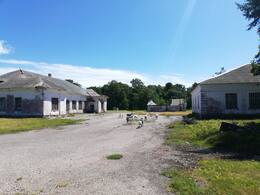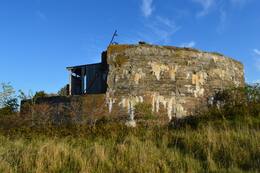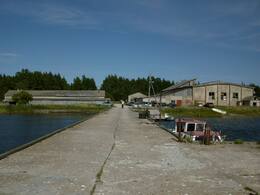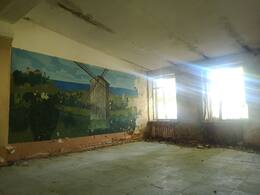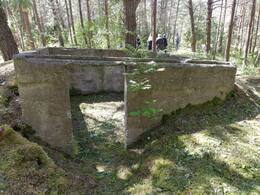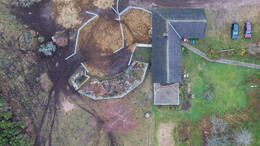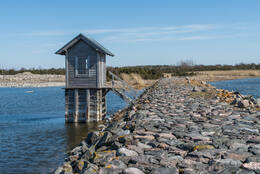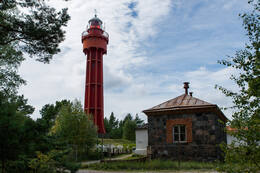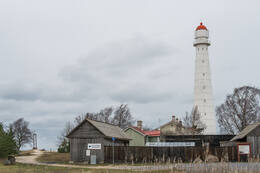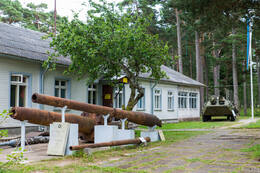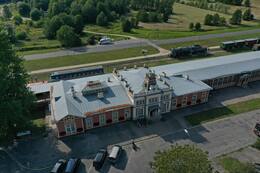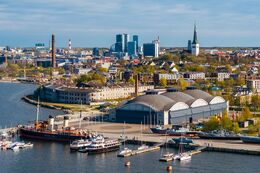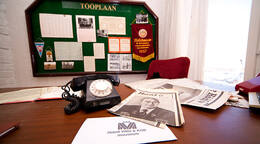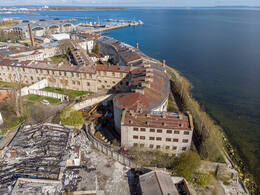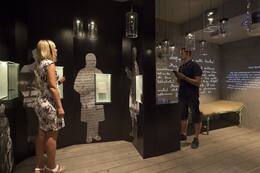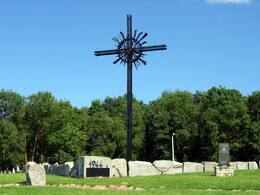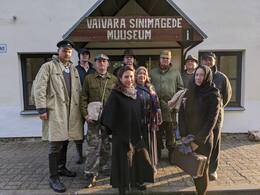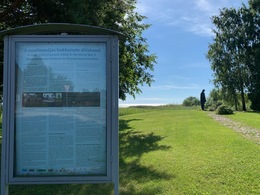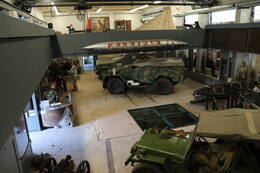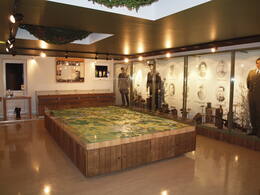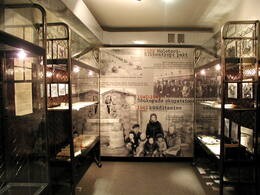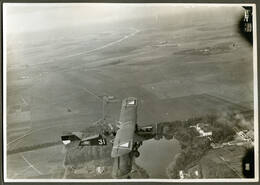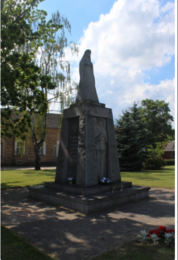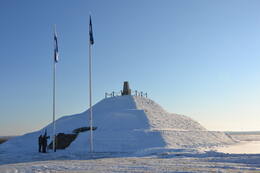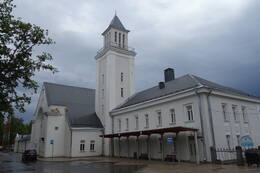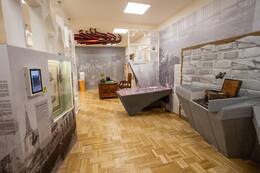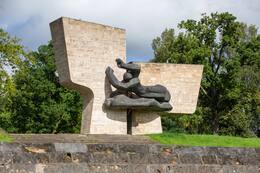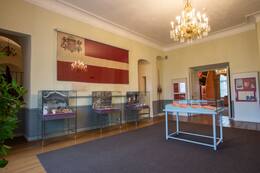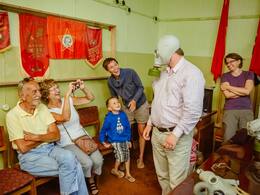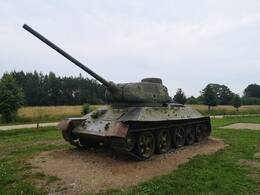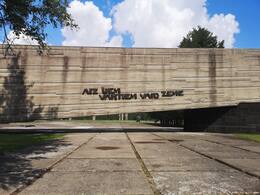The Great Cross-Border Route - Military Heritage of Latvia and Estonia over 100 Years
Christmas Battle Museum
The museum is located in “Mangali” house, Valgunde Ru ral Territory, Jelgava Municipality, and it is a branch of the Latvian War Museum. It was unveiled in 2005 at the site of the Christmas Battles that occurred during World War I. Unique World War I fortifications still remain at the battle sites. The open-air exhibition of the Christmas Battle Mu seum reconstructs a section of the fortification system – the trench shelter and part of the first line of German defence – the “German rampart”, which is the only object of this kind in the Baltic states. The Christmas Battles are one of the best known and most dramatic events of World War I in Latvia. They are an event of special importance in Latvian military and cultural his tory. Intense fighting took place for six days, leading to heavy casualties. The battles are mainly associated with the attack of Latvian Riflemen against the German Army units, which took place in particularly severe and unfa vourable winter conditions. This is an unprecedented case of a major combat operation launched without artillery support. Today, the museum artefacts found at the sites of the bat tle are on display. The indoor exhibition is open at certain times, while the exhibition of outdoor fortifications is open every day. Tourist routes and nature trails have been cre ated in the surrounding area.
Lestene Brothers' Cemetery
Located in Tukums region, Lestene, next to the church.
The construction of the Brothers' Cemetery in Lestene began in 1998. It is the second largest cemetery of soldiers in Latvia, where more than 1,300 Latvian legionnaires are buried together. Only after the restoration of the Republic of Latvia was it possible to bury Latvian soldiers who died in World War II from various places.
The Latvian Legion was a combat unit of the German army, formed mainly from illegally mobilized Latvians. The soldiers perceived their presence in the legion as a struggle for the restoration of Latvia's independence, despite the fact that it took place in the ranks of the German armed forces and that Germany had occupied Latvia. There was no other military force that could delay the return of the Soviet occupation. Latvian legionnaires fought against the Red Army, which had abolished Latvia's independence, destroyed its army and committed crimes against civilians. Between 110,000 and 115,000 soldiers fought in the ranks of the German army, and between 30,000 and 50,000 of them left their lives on the battlefield.
Today in Lestene you can see the Brethren's Cemetery, next to which is Lestene Church. It is an outstanding example of baroque sacred art. In the old church pub you can get acquainted with the exposition dedicated to the history of the Latvian Legion. The central image of the Brothers' Cemetery "Motherland - Mother - Latvia" was created by the sculptor Arta Dumpe. Nearby is Lestene Manor, which belonged to the Latvian Army General Mārtiņš Hartmanis before the Second World War.
Excursions to Lestene Church can be booked at the head of the parish of Lestene Evangelical Lutheran Church Inguna Kokina, phone +371 29993743.
Museum of the National Resistance Movement in Renda
The museum is located a few kilometres from the centre of Renda parish. The exhibit tells about the 50-year-long resistance movement in Latvia: resistance to the first Soviet occupation, resistance to the Nazi German occupation, and the armed and non-violent resistance to the Soviet occupation. The exhibit is located in two buildings. The first building houses evidence of the first Soviet occupation and German occupation. The exhibit showcases a restored barn building where the focus lies on the National Partisan War. Between the two buildings there is a bunker with an authentic layout and trenches used by soldiers. Located near the museum in Renda, excavations, blindages and an obstacle course serve as a training ground for youth guards and anyone interested. Visits must be booked in advance.
One of the largest battles of the national partisans, called the Āpūznieki Battle, took place in January 1946 not far from here. The battle saw the Kabile National Partisan Group overpower much larger forces of the occupying power. Featuring information stands, the battle site is now home to a rest area.
Collection of Soviet Military Vehicles
Edgars Kārklevalks owns a guest house called Pūpoli in the Dundaga region, and for more than 15 years he has been taking people on historical and educational trips around northern Kurzeme (including to former military areas) with his own renovated Soviet Army truck GAZ-66 (up to 24 persons) and UAZ-3151 (up to 6 persons). Soviet Army trucks and other equipment are showcased in an area around the guest house.
Oviši Lighthouse and Soviet border guard
Oviši Lighthouse is located in the Tārgale parish in a village called Oviši on the coast of Kurzeme. It was built in 1814 and it is the oldest lighthouse in Latvia. The height of Oviši Lighthouse tower is 37 m. The lighthouse has a double-cylinder design: its diameter is 11.5 m, but within the stone wall there is a second tower with a diameter of 3.5 m. Such double-cylinder lighthouses were used also as defensive structures in the 18th-19th century Europe in case of enemy attacks. The Oviši Lighthouse Museum is considered to have the largest collection of lighthouse equipment and maritime navigation items among all Latvian lighthouse museums. When the weather is right the Irbe Lighthouse can be seen from Oviši Lighthouse.
At the end of World War II, the headquarters of the Beminger Battalion of the German Army was located near the Oviši Lighthouse along with the 4th Battery of the 530th Naval Artillery Division with several anti-aircraft guns. It is said that there was a radio direction finder and an infrared ray detection station Donau Gerät located at the foot of the lighthouse. A Soviet border guard post was once located near the lighthouse, but none of the Soviet-era buildings have survived. The Oviši station building is still located in the territory of the lighthouse.
Fire correction tower of the Ventspils 46th Coastal Defence Battery
The restored fire control tower of the 46th Coast Guard Battery in Ventspils is located on Saulrieta street and is available to visitors in the form of an observation tower. There are four artillery gun positions near the tower and it is the only World War II coastal defence battery in Latvia in such a good condition. Visitors can take the tower stairs to an outdoor viewing platform overlooking the sea. An information stand with a QR code is available next to the tower. You can use the QR to watch an animation about historical events. There is a new street leading to the tower, a large parking lot and a wooden footbridge that crosses the protected nature area next to the tower.
This military complex was built in 1939, marking the start of construction of USSR military bases in Latvia. The 46th Coast Guard Battery had four positions for the gun type Б-13. This battery had its first military engagement on 24 June 1941, when Ventspils harbour was attacked by German torpedo boats that were driven away from the shores of the Baltic Sea by battery fire. On June 28 the Soviet Army blew up the guns and left.
Narrow gauge railway train “Mazbānītis” in Ventspils Seaside Open-air museum
In the Seaside Open-Air Museum in Ventspils you can take a ride on two narrow-gauge railway lines with the train ‘Mazbānītis’. The Circle line is 1.4 km and the Mountain line is 3 km. ‘Mazbānītis’ is the locomotive that transported passengers and cargo on 600 mm narrow-gauge railway tracks between 1916 and 1963. It is a legacy of military history from World War I that once played an important role in the cultural and economic development of northern Kurzeme by connecting settlements and providing new jobs.
Construction of a large 600 mm narrow-gauge railway network is largely associated with World War I, when the German Army in 1916 started the construction of several so-called military field railways (Heeresfeldbahn in German) in the occupied territory of Latvia. These railways could be quickly constructed, deconstructed and moved to another front line. The Latvian narrow-gauge railway network was used also during World War II. For almost 60 years the narrow-gauge railway was the only safe way of transporting passengers, various agricultural products and timber to cities in both winter and summer.
Former Soviet border guard observation tower in Pāvilosta
The Soviet border guard observation tower is located near the South Pier in Pāvilosta. The former Soviet border guard observation tower, which had been out of use since the early 1990s, now serves as a viewing platform with a 360-degree rotating land telescope. It offers beautiful views of the sea and ships and can be used for bird watching. Ascending the tower is only allowed during daylight hours in the summer season. As the stairs in the tower are quite steep, visitors should evaluate their abilities, health and associated risks. The observation tower and the surrounding area has video surveillance. The tower is closed to visitors during the winter season.
Pāvilosta local history museum exposition
Named ‘Pāvilosta, a Closed Area’, the exhibit in the Pāvilosta Local History Museum is about everyday life in the town of Pāvilosta during the Soviet occupation; specifically, about the executive branch, border area, fishermen’s collective farm, and the cultural and social activities. In addition to the permanent exhibit, there is an interactive and emotionally rich digital exhibit in two languages and an audio-visual installation offering a film about Pāvilosta.
The museum also features a new exhibit named ‘The Golden Sand Grains of Pāvilosta’. The digital installation showcases old events, how Pāvilosta was founded and the most important developments from 1918 to the present day. Military heritage is a point of focus in the War of Independence section, which tells a story about the freedom fighters of Latvia and the time of the Soviet occupation.
Akmeņrags Lighthouse and the fate of the "Saratov"
The Akmeņrags Lighthouse is located in Saka parish, 10 kilometres southwest of Pāvilosta. The top of the lighthouse can be reached by a spiral staircase and it offers views of the sea and the surrounding forests. Standing at 37 metres high, the current lighthouse tower was built in 1921, while the previous lighthouse was destroyed during World War I.
The Akmeņrags Lighthouse stands out among other lighthouses in Latvia, as it is located in one of the most dangerous places for sailing in the entire Baltic Sea coast. The signal beam of the lighthouse marks a rocky bank, which extends approximately two nautical miles or 3.7 kilometres into the sea in a north-western direction. The depth of the bank is just over two metres. The location of the lighthouse has remained unchanged, but the coastline has been receding over the years. Although a navigation light has been here since 1879, Akmeņrags has seen several shipwrecks. The most notable occurred in September 1923 when a Latvian steamer named Saratow struck the ground. In 1919, Saratow briefly served as the seat of the Latvian Provisional Government. Akmeņrags used to be home to a border guard post, and buildings of the Soviet Army are can be viewed here.
Memorial to the victims of holocaust in Liepāja
The largest memorial to Holocaust victims in Latvia is located in Liepāja, in the Šķēde dunes. The memorial is dedicated to the memory of more than 3,000 Liepāja Jews killed during World War II. It is in the form of the Israeli national symbol, a seven-branched candelabra known as the menorah. The contours of the memorial, which are clearly visible from a bird’s eye view, are made of split boulders and granite blocks. The ‘lights’ of the menorah are made of granite pillars with inscriptions of verses from the Lamentations of Jeremiah in Hebrew, English, Latvian and Russian.
Liepāja Northern Fort and Battery Nr.1 in Karosta
The Northern Forts are the best known and visually most impressive part of the Liepāja Fortress. Built by the Russian tsarist army in the late 19th century, their historical name is Fortress Battery No 1.
In November 1908, less than 10 years after its construction, the Liepāja Fortress ceased to operate, because its construction was acknowledged as a strategic mistake. Some of the cannons were dismantled and taken to the Kaunas Fortress in Lithuania, while others were remelted. Fortification structures were detonated twice in an attempt to destroy the fortifications. Elements surviving to the present day include artillery batteries not fully destroyed in the explosions and underground structures. Just like the Karosta, the Northern Forts were a closed military territory during the Soviet occupation. Visitors to the Northern Forts should be very careful. As in other places on the Latvian coast, the steep shore of the Baltic Sea in the Karosta is dangerous due to potential coastal landslides. Therefore, it is not allowed to walk under the ruins of the forts.
In the northern part of the fortress was located one of the four coastal defence batteries, Battery No.1. The battery was to house six 6-inch (152 mm) guns of the 1892 model of the Canet system, six 11-inch (280 mm) guns of the 1887 model and two 57 mm Nordenfeld anti-ship guns. Only the guns of the Canet system had a long enough firing range to withstand possible shelling by the German Navy. Thus, at the time of the liquidation of the fortress, the armament was only partially installed.
Karosta, the Military port of Liepāja (tour)
The Karosta is the largest historical military territory in the Baltics and occupies almost one third of the entire territory of Liepāja. The Karosta is a unique compound of military and fortification buildings on the shores of the Baltic Sea with a special meaning in the history and architecture of Latvia and the world. The Karosta features such military heritage sites as the North Pier and forts, the Redan, Karosta Prison, Karosta Water Tower, St. Nicholas Orthodox Maritime Cathedral, Oskars Kalpaks Bridge and others.
Cattle wagon used for deportations – museum at Skrunda train station
To commemorate the deportations of June 1941 and March 1949, a memorial stone and a four-axle wagon, which also serves as the museum dedicated to deportations, was erected at the Skrunda railway station. This is the first wagon-type museum in Latvia that holds a permanent exhibit of photos, letters, memoirs, documents and various items made by the people deported from the Skrunda station. Skrunda station was a location where deportees were gathered, and one of the three stations in the region to which people from the Skrunda and the Kuldīga area were brought. In 1941, the family of the first President of the restored Republic of Latvia, Guntis Ulmanis, was deported from here to Krasnoyarsk Krai in Siberia.
With the help of deportations, the Soviets dealt with supporters of the national partizans’ and at the same time intimidated the remaining rural population, forcing them to join the collective farms.
Skrunda Manor and exposition of Skrunda locator
Skrunda manor has an exhibit about the Skrunda radar (Skrunda radio location station) and the activities of the Latvian Popular Front in Skrunda. The Skrunda radio location station nicknamed ‘Kombināts’ (The Plant) was a USSR missile early warning system in the western sector. Location ‘Skrunda-2’ was a special town (в/ч 18951) created 5 km from Skrunda in the direction of Kuldīga for the needs of the USSR military. The radar station Dņepr operated from here and a new, more modern station Darjal was being built. Construction was stopped and the radar station Darjal was blown up on 4 May 1995. In compliance with an international agreement the radar station Dnieper was shut down on 31 August 1998.
Oskars Kalpaks Museum and Memorial Site “Airītes”
The Oskars Kalpaks Museum and Memorial Site Airītes is located between Saldus and Skrunda near the A9 highway. The exhibit has extensive information about Colonel Oskars Kalpaks and his battalion, and shows the history of the Latvian National Army and the memorial site Airītes. The exhibit reveals Colonel Oskars Kalpaks as a personality, as a soldier and as a fighter for Latvia's independence. Audio logs in Latvian, English and German are also available as part of the exhibit. They emphasize the importance of the historic events of 1918/1919 in the protecting the statehood of Latvia. The museum building has been restored.
Entry is free; guided tour – for a fee. The complex has a recreation area, a park, an obstacle course, it is possible to take various classes, and there is a seminar hall for up to 30 people.
Soviet Army Observation Tower (Kurgan of Officers)
The "Officers' Kurgan" is located less than a kilometre from the ruins of Zvārde Church. The Kurgan is made of the ruins and remains of the surrounding houses and manor house, which have been bulldozed together. An observation tower was built on the kurgan. According to the inscription, the present tower was built in 1981. The tower was used to record bomb hits. The training bombs had a reduced explosive content, so their hits had to be watched more carefully. Unexploded bombs were neutralized immediately, but not all could be found.
The remains of the tower can be seen here today - the brick walls. As the barrage is relatively high, you can even see the Lithuanian oil refinery in Mažeikiai on a clear day.
Olaine History and Art Museum
The exhibit in the Olaine History and Art Museum is about the period of Soviet occupation in Olaine. A World War I exploration route with restored elements of the fortifications has been created in the territory of the museum. On the site, where the World War I Russian Army defence line once was, a Russian soldier-type dugout has been built and a fragment of a shooting tower can be viewed by visitors. A World War I reinforced concrete fortification can be seen in Jaunolaine, at the intersection to Plakanciems. During World War I, active battles were fought between the Russian and German armies in this area. Latvian Riflemen units were involved in intelligence and various other operations. Marshy lands made it difficult to defend, but this was a very important area in Latvian military history. Olaine was formed due to the convenient location between Jelgava and Riga, where Jaunolaine is currently located. The Olaine manor was nearby. The modern day Olaine was built during the Soviet occupation, when industrial companies began their operations there.
Mangaļsala fortifications
Coastal fortifications are located in Riga, Mangaļsala, at the mouth of the Daugava across from Daugavgrīva. Fortifications built by different armies (Russian, Latvian, German and Soviet) can be seen here. The fortifications of Mangaļsala were built to defend the city of Riga from hostile navies. This area was strategically important for a long period of time. After World War I the Latvian Army did not yet have a strong navy. The maritime border was long and coastal defence was becoming an increasingly difficult task. The Latvian Army took over the fortifications built by the Russian Empire in the end of the 19th century and beginning of the 20th century and expanded the defence system. The artillery of Daugavgrīva and Mangaļsala would open fire on enemy ships trying to enter the mouth of Daugava, while support points at the mouth of Lielupe (Jūrmala) and mouth of Gauja (Carnikava) would stop enemy landing parties. There was also a specially equipped armoured coastal defence train that could provide artillery fire and support in the direction of Saulkrasti or Jūrmala. The aim of fortifying strategic sites was to maximise the use of weapons through special constructions and terrain advantages. Coastal defence fortifications were spread out over a large area to counter enemy efforts in the event of war.
Audio guide https://izi.travel/en/edbf-mangalsala-fortifications/en
Soviet army town in Mežgarciems
The former Soviet Army town is located in Mežgarciems, Ādaži municipality, near the P1 highway. It was a small town inhabited by the air defence units of the Soviet Army and used as a military training base. Informative stands have been placed near the town. The former army base area is available to visitors. Mežgarciems did not exist on the maps during the Soviet occupation. And there was nothing to suggest that there was a small town built for the Soviet military with air defence capabilities. Wide-spread construction of Soviet Army stations was rapidly started in the territory of Latvia after World War II. And these army bases were like separate states within the country. There were military units almost in every location in Latvia. An especially privileged part of the society was the retired USSR military personnel and their families, who were entitled to living space as a matter of priority. Many chose Latvian cities, because the standard of living here was higher than elsewhere in the Soviet Union. The presence of the Soviet Army in Latvia was characterised by criminal behaviour, imperialistic attitude and impunity, demonstrating the regime’s indifferent attitude towards Latvia and its people. And the carefully maintained myth of the happy life in Soviet Latvia and the Soviet Army as the liberator was actually like living on a powder keg.
Exposition of Ādaži garrison history
The exhibit of Ādaži garrison history is located in the territory of the National Training Centre in Ādaži, Kadaga. In this exhibit visitors can get acquainted with military equipment and learn more about the everyday life of a soldier. The largest firing ground in the Baltic States and a unique training area is located in the vicinity of Ādaži. The history of the firing ground dates back to the 20th century. At the end of the 1920s it was set up near Riga in the vicinity of Lilaste. After World War I and the Latvian War of Independence the Latvian Army was formed in a war-torn country. Latvian people had lived through war and seen the indifferent attitude of foreign armies. In a relatively short period of time the army became a large force with extensive reserves. Firing grounds and summer camps were made to resemble war conditions thus allowing the soldiers to improve their skills and knowledge. The Riga-Saulkrasti railway line, built in the early 1930s, became an important factor in the development of the Lilaste (also known as Gauja) firing ground, because it allowed easy transportation of ammunition and equipment, and it could also be used for coastal defence operations. During the Soviet occupation the firing ground was significantly expanded symbolising the military might of the Soviet Army.
Garrison – a group of military units that have been indefinitely or temporarily stationed in a certain administrative territory.
Firing ground – a place for testing equipment and training troops.
Exposition of military bikes in the Bicycle museum in Saulkrasti
The Bicycle Museum is located in Saulkrasti not far from the A1 highway and the railway station Pabaži, near the White Dune. Museum’s collection is made up of technically the most interesting examples of bicycle development history in Latvia. It is the largest bicycle collection in the Baltics with about 60 bicycles made and used in Latvia, including army-type bicycles. In the beginning of the 20th century many armies started to widely utilise the availability and benefits of bicycles. Special bicycle units were formed because of their mobility. Bicycle units were able to gather intelligence and launch unexpected attacks more easily, and were more mobile than regular infantry when it came to operations over a wide area. After World War I the Latvian Army also had bicycle units who used Latvian-made army bicycles. Any soldier who was in such a bicycle unit had to meet strict requirements. Good stamina, eyesight and hearing, as well as a healthy heart and lungs were a must. They could not weigh less than 80 kg and their height had to be 165-180 cm. The standard in the Latvian Army was that a well-trained cyclist should be able to cover 80-100 km in day, and up to 150 km in forced conditions. In winter, when bicycles could not be used, skis were used. A soldier from a bicycle unit had to be able to ski 50-60 km per day. Many soldiers from bicycle units would later become professional athletes.
We have about 5000 visitors every year.
War of Independence Monument in Pärnu
This monument was designed by Amandus Adamson. It was unveiled in Alevi cemetery in Pärnu on 16 July 1922. Its designer was buried next to it in 1929.
On 15 April 1945 the monument was blown to pieces, which were then buried. The statue of a boy with a garland was buried by local high school girls 175 metres from the monument. Luckily the graves of the soldiers were left untouched.
The garrison cemetery was renovated in 1987 and the parts of the monument (incl. statue of the boy with the garland) were dug up in 1988. On 24 February 1989 the upper part of the monument, which was found buried in its original location, was unveiled with a granite tablet reading: "1918 1920 / HERE WAS UNVEILED, ON 16 JULY 1922 THE MONUMENT TO THOSE / FALLEN IN THE WAR OF INDEPENDENCE / SCULPTOR AMANDUS ADAMSON / DESTROYED IN 1945 / 24 II 1989 P.M.S." The full restoration of the monument and cemetery was completed in stages. The monument was unveiled anew on 17 July 1993.
Monument to Proclaiming the Independence of the Republic of Estonia
This monument is situated on Independence Square in the centre of Pärnu.
Made from granite and designed by Kaarel Eelma, Mart Aas and Mikk Mutso, it was unveiled in 2008 near the former site of the Endla Theatre.
On 23 February 1918 the Manifesto to the Peoples of Estonia was publicly declared for the first time from the balcony of said theatre, which was badly damaged in World War II and later demolished.
The monument depicts the balcony of the historical theatre in its original size. It displays the text from the manifesto in both the original blackletter typeface and Antiqua, as well as in Braille.
The manifesto was published and the Republic of Estonia declared in the capital Tallinn on 24 February, transferring all authority to the Estonian Salvation Committee, later followed by the Provisional Government. 24 February 1918 is celebrated to this day as the anniversary of the Republic of Estonia.
Estonian Museum Railway in Lavassaare
The Estonian Museum Railway is situated on the old peat industry site in Lavassaare, 17 km north-east of Pärnu.
The museum is the only narrow-gauge railway museum in the country, displaying, among other exhibits, a functioning steam locomotive. It has in its collection over 80 railroad cars, including five locomotives and a variety of technical apparatus, most of it on display outdoors. The peat workers’ residential building on the museum premises houses an indoor exhibition displaying over 700 historical photos, items and documents related to narrow-gauge railways in Estonia.
The narrow-gauge network in the Governorates of Estonia and Livonia was established during the 19th and 20th centuries for the development of regional industry.
WWI Defense Ditches at Väike Väin Strait
The clearly visible segment of World War I trenches by the Väike Strait is situated next to the Kuivastu-Kuressaare road near the popular tourist attraction of Eemu Windmill on the island of Muhu.
These trenches make up a small part of a larger area of defensive fortifications and facilities covering many kilometres. They were dug from 1915-1917 as a defensive measure against the advancing German army and were used during both world wars.
The renovated site is a great example of the military history of Muhu. This zigzagging trench is clearly visible. It is easily accessed by visitors, as it is situated right by a main road with a car park next to it. Historic wire fencing only adds to the scenery.
This example of military history complements the historic Eemu windmill, an industrial heritage site nearby, which survived World War I but was destroyed in World War II, before being restored in 1980.
Military Equipment Museum of Saaremaa
The Military Equipment Museum on Saaremaa was established in 2007. Its collection comprises the private items (approximately 12,000 of them) of its founding members.
The museum organises themed hikes and re-enactments of historical battles showcasing the military history of the 20th century. Covering 650 m2, the museum comprises five exhibition halls open to visitors, including an outdoor exhibition (of larger military equipment). The centrepiece of the War of Independence Hall is the machine gun wagon of the 3rd Armoured Train. The exhibition displays original uniforms, weapons and other personal equipment from the War of Independence (1918-1920). The Hall of Historical Uniforms displays the original uniforms of the Estonian Defence Forces and Defence League from the interwar era (1925-1940) and original uniforms from World War II, along with other equipment. The Hall of Weapons displays European firearms and sidearms from 1450-1970. The Hall of World War II Personal Equipment and Kitchenware provides an overview of soldiers' everyday items. The Hall of Technical Equipment displays communication devices, cannons, mortars, bicycles, motorcycles and cars.
Saaremaa Museum
Kuressaare Castle is situated on the southern edge of the Kuressaare town, by the sea.
The anniversary of Saaremaa Museum, which is housed in the fortress, is celebrated on 17 February: the date in 1865 when the Society for Research of Saaremaa (Verain zur Kunde Oesels) was founded. The museum relocated to the castle in 1897. Its exhibition showcases the nature and history of Saaremaa. The largest and most noteworthy exhibit at the museum is the castle itself, which a fine example of the development of military fortifications between the 14th and the 19th centuries. Kuressaare Castle is one of the most authentic fortifications anywhere in Northern Europe.
Maantee Military Base
This military base in the village of Maantee is situated on the island of Saaremaa, on both sides of the old highway a couple of kilometres from Sõrve Military Museum.
Construction of the barracks here began in April 1940 after the signing of the Mutual Assistance Pact. The base was constructed by a local company, A. ja M. Edenberg. It comprised two barracks accommodating 350 soldiers, a canteen, a bread factory, a bathhouse, an officers' mess, a clinic and an ice house. The base housed the detachments of the 315th coastal defence battery. Existing farmhouses were demolished to make way for the new facilities, forcing many to move. After the war, the detachments manning the coastal defence batteries in the vicinity were stationed here. The barracks were put back into use during the Cold War, this time by missile troops. In July 1960 the 74907th Division equipped with S-75 missiles arrived here. They began building the Granit missile depot near the barracks. The other barracks housed a single radio-technical company. In 1972, three air defence missiles fitted with nuclear warheads were stored at the Granit depot. The missile unit was disbanded in January 1991. The radio-technical company left the village of Maantee the following year.
Today the buildings are dilapidated to the point of posing a danger. The metal doors of the missile depot have been removed. Nevertheless, the complex remains a popular tourist attraction, albeit one at which visitors must be cautious of the potential hazards.
Coastal Battery No 43 at Sõrve Säär
This coastal defence battery is situated on the shores of the Gulf of Riga in the village of Sääre on Saaremaa.
Sääre was the site of the 43rd coastal battery of the Moonsund forward position of Peter the Great's Naval Fortress, also known as Zerel. It comprised four 305-mm guns. Construction began in 1914, during World War I, on a limited budget. The artillery pieces were mounted in the open on barbettes, with a narrow firing range over Irbe Strait. These were accompanied by ammunition dumps, diesel generators and a command centre built from logs and surrounded by sand. The wooden fire control tower was around a kilometre away at Sääre Manor. A 5 km long narrow gauge railway was laid connecting the battery with the port in Mõntu.
The concrete artillery barbettes with their rounded bolts, defensive walls of two of the artillery positions and the mound of sand on which the command centre once stood are all that remain today.
Papissaare Seaplane Base
This seaplane harbour is situated on Papissaare Peninsula, to which an historic cobbled road leads from the small borough of Kihelkonna.
Papissaare Seaplane Base, which formed part of Peter the Great's Naval Fortress, was established between 1912 and 1914. It comprised two aircraft hangars, equipment and ammunition warehouses, a fuel tank, an electric generator, barracks, a canteen, a bread factory and a bathhouse. In August 1914, nine aircraft were brought here from Liepāja. On 12 October 1917 German forces captured the base and destroyed most of the buildings. During the interwar era the complex was the site of Julius Teär's Shipyard.
On 24 October 1939, Soviet forces acquired the complex under the Mutual Assistance Pact and restored it as a seaplane harbour. The MBR-2 seaplanes of the 15th Aviation Squadron stationed here fought in the Finnish Winter War. In late summer 1941, German bombers obliterated the seaplanes. The Soviet squadron abandoned the base, setting it on fire as they did so. From 1940-1960 the whole peninsula was a restricted military zone. Later, the complex was used by the local fishing collective. Today the remaining buildings are in use as workshops and warehouses.
This historic seaplane harbour has become an important tourism port, providing passage to the unique island of Vilsandi.
Naval Communication Station in Undva
Undva is situated in the north-eastern part of Tagamõisa Peninsula in north-western Saaremaa. In August 1940, Soviet forces and locals recruited for construction began building the 32nd Military Base in Undva. After World War II, the Soviets built two 127-mm artillery batteries here, one near Suuriku Bank and the other on Cape Undva. The latter was later replaced with a more modern coastal defence battery, which preceded the construction of a radar station in the 1960s. The four concrete barbettes, concrete hangars and the remaining complex are in good condition.
Panga Military Trail
This military hiking trail is situated on the north coast of Saaremaa, 1.5 km north-west of the village of Panga. The most convenient access to Panga is via Võhma.
The trail is situated along Panga Bank, which is the highest bank of exposed bedrock anywhere in Western Estonia and on the islands. Its length and openness to the sea are what make the bank special in terms of terrain and attractive to tourists. It is situated in Panga Nature Park, surrounded by the Baltic Sea to the north and north-east, by the mouth of Küdema Bay (an important bird site) to the west and by forests to the south and east.
Panga Bank did not see any active combat. The area was used for defence purposes, as it was a restricted access zone on the border of the Soviet Union.
The sundial marks the place where a searchlight once stood, guarding the national border.
Today the 2 km long military hiking trail passes by the ruins of a variety of military facilities.
120-mm Battery No 34 at Hindu (Sõru)
The construction of the battery began in 1914. As it was an additional battery, missing in the original plan of the naval fortress and the type of guns was repeatedly changed. Finally four 120- mm Vickers guns were installed. A 200-m length and 10-20-m width sandbar was piled up in defence of the gun emplacements and covered in concrete above the guns. Hindu was the only battery in Hiiumaa that participated in combat operations during the Tagalahe landing on 12 October 1917. After a brief exchange of fire with the German warships the Russian artillerymen fled, leaving the battery intact. The Germans sent a landing unit of soldiers inland that blew up the guns of the battery. One of the German warships that shot Hindu battery, was ’Bayern’, the warship with the largest displacement that has ever been in the Estonian waters (length 180 m, displacement 32 200 tons, eight 380-mm guns).The building of the battery radio station was transported to Emmaste and was used as the community centre (demolished in the 1980s). The gun barrels and other larger details were still there in 1937. Today the first and the second gun platforms are still identifiable, the other two are situated on a fenced farmyard. The third gun crater is filled with earth and there is a newly built house facing the sea, the remains of the fourth one is merely a cracked concrete platform. Out of two air defence gun platforms, one survives (a hundred metres toward the nursing home, on the right side of the road). There are no intact buildings. The machine gun bunker between the first and the second emplacement was completed in 1941.
Concurrently with the construction of Hindu battery, there was a plan to build something in Lepiku village where large gravel bars were piled up, still visible today. It is unknown what the building was going to be.
130-mm Coastal Battery No 44 at Tohvri (Hindu)
A building battalion of the Red Army arrived in Hindu village in October 1939. The local population was ordered to leave their homes before winter. By the following spring the battery area was surrounded by a wire fence. Building material arrived via Sõru Port where work was done in 3 shifts, 24 hours a day. At least a hundred local men were employed to build the battery. Concrete mix was manually made in large tubs, foundation holes were dug. The barracks were going to have two storeys, the second storey angle iron framework was completed when the top committee came to check on the construction. An order was given to demolish the second floor because it was visible from the sea. By the autumn of 1940 two barracks, two officers’ residential buildings, a canteen, two saunas, a food cellar, two firefighting water reservoirs and a gate guard post were completed. A large-scale construction was to continue and there were a couple of thousands of tons of cement in the depots.
The crew of the battery included 5 officers and 125 lower rank soldiers. The test firing of guns took place in summer 1941 when boat-like vessels with masts towed by tugboats on long wire ropes appeared. The battery was never fully completed, some of the shelters and the water reservoir are not covered with earth. The armoured doors were probably never fully installed. Just the concrete floor of the gas shelter (shelter-power station) with its spiky reinforcement iron bars got completed. One gun and its crew were taken to Heltermaa in September 1941. During the German landing in October an ammunition shelter together with the rest of the battery’s ammunition were blown up. The powerful explosion ripped and scattered the walls of the explosive charge room and raised its roof into the air which broke in two after falling on the standing wall.
The other three gun blocks have survived more or less intact and dry. Recently, the area has been cleared and the positions can be fairly easily identified. The command post is half filled with water the whole year round. Due to its wet location the ferroconcrete and bricks are in a notably worse condition than in Tahkuna.
Around the battery there are five machine gun bunkers, each of a different construction. A couple of hundred metres to the Northwest of the battery position there is a small open observation post. There are two machine gun bunkers by the base as well. Near the upper lighthouse of Sõru there are the ruins of a machine gun bunker with a shooting sector of laid bricks. At least 15 such weapon pits were built between Tärkma and Õngu in 1941.
In 1944–1945 the battery was reconstructed with three 130-mm guns. The last training shots were taken on 23.09.1957. The following March the guns were taken away and then the battery was closed down. Today the former base accommodates Tohvri nursing home.
Orjaku Military Harbour
Orjaku harbour was intended to be used as an Imperial Russian Navy base for torpedo boats. Construction began in 1912, only to grind to an indefinite halt following the outbreak of World War I. Just two breakwaters had been completed by this point, which encompass the harbour to this day. During the final years before the Soviet occupation, a channel 4 metres deep, 35 metres wide and 2.2 km long was dredged.
Ristna Lighthouse
This 30-metre, cast-iron lighthouse was assembled in 1874 from components manufactured in France. The lighthouse was badly damaged during World War I and was reinforced with a concrete outer structure in 1921.
The lighthouse itself is 29.5 metres high, while its light towers 37 metres above sea level. The light can be seen from 31.5 km away.
The lighthouse was also tasked with warning vessels about the ice conditions in the Baltic Sea, alerting them with a blinking red light if the nautical channels were blocked by ice.
This lighthouse is connected to events of the First World War: On 12 August 1914 at 4 AM the German cruiser Magdeburg fired at the Ristna lighthouse and the communications outpost on Cape Ristna. This marked the arrival of the First World War on Estonian territory. Ristna lighthouse was used for communication between patrolling British and Russian submarines and the naval base in Tallinn. Radio communication was avoided. The submarines surfaced at the agreed-upon location and sent their communication officers to the base by the lighthouse to make contact with Tallinn on the phone to receive further instructions. On the same day the Russian Navy used a fairly rare contraption of that time, a hydrophone, to record any noise generated by ship propellers on Cape Ristna. The coastal outpost and cables were destroyed while the Russians retreated, the remains of the hydrophone are still deep on the sea floor to this day, its location unknown. It is worth mentioning that the fog siren building erected in the early 20th century is one of the few surviving fog siren buildings of Estonian lighthouses.
The 130-mm Coastal Battery at Tahkuna No 26
The 130-mm battery at Tahkuna is architecturally similar to the battery at Tohvri. The ferroconcrete surfaces in the gun emplacements bear the inscripted date 20/IV 1941. In 1941 the battery had four 130-mm B-13 guns (weight of gun including shield 12.8 tons, crew 11, shooting range up to 25 km). The crew included 151 seamen and 9 officers. The guns were installed right before the battles of October 1941.
The ferroconcrete gun blocks remained intact in the war and the crew arrived as early as October 1944. First the battery had three 130-mm B-13 guns. The last shots were fired in Tahkuna in January 1960 when there were 4 guns. When the battery was operating, the last kilometre of the road leading to the lighthouse was closed by a barrier and a gate house and this part of the road is still missing on the military topograhic map published in 1959.
The buildings of Tahkuna battery have survived in a fairly good state. In the ammunition depots next to the gun blocks occasional shell shelves have survived, they can also be found in the ammunition depots in the rear of the emplacements. The shelter-power station (the gas shelter) still has bunk beds. Between the boiler house and the diesel power station there is a particular water line hidden in a high parapet with a concrete reservoir at both ends. A fire control tower was built next to the command post in the 1950s and after the battery was closed down, it was used as an observation post of the naval radio technology unit. As the forest kept growing and the seaview got worse, the tower gained another floor. This new addition demonstrates a notably poorer building quality in comparison with the rest. The added floor includes a stove, whereas originally the tower had central heating. On the whole territory of the battery there are cable ditches that have been dug open – dating from the 1960s when the collective farms were permitted to take electric gear from the abandoned batteries, as well as from the early 1990s when all the cables that had been meanwhile installed and could be spotted, were taken. With the territory being completely neglected and heavily overgrown, finding and studying the objects could be complicated.
On the territory of the battery, next to the parking lot, there is a monument from 1968 in memory of the Baltic Navy soldiers who perished in 1941. The author of the monument is Vitali Navoznyhh, originally from Leningrad. He participated in the battles of 1941 in Hiiumaa and settled on the island after the war, working as a stonecarver. Next to the monument there is a tombstone to two unknown soldiers who were buried there in 1973.
Railway and Communications Museum in Haapsalu
This museum is housed in a train station built in the early 20th century to service the railway line connecting to the resort in Haapsalu.
Opened in 1997, the museum showcases the one-and-a-half centuries of development of Estonian railways and mediums of communication. Besides decommissioned locomotives, the museum displays an affable station master and an Ericsson Skeleton Type telephone and invites visitors to the station's post office.
The outdoor exhibition also displays a World War II steam locomotive 52 3368.
The steam locomotive 52 3368, initially numbered 16494, was completed in April 1943 in Munich at the Krauss-Maffei Works and then transported to Austria, the Bruck an der Mur depot of the Villach division. The Hungarian State Railways (MAV) rented the locomotive and on June 7, 1945, it was captured by the Red Army. When the Hungarian-Romanian border was altered, locomotive 52 3368 was given to the Romanian railway (CFR). In August 1950, at the CFR Iași Works the locomotive was converted to broad gauge (5 ft) and given to the Soviet Union, where it operated at the Kotovsk and Vapnyarka depot of the Odessa Railway from October 1950 to 1956. After that, the Ministry of Transportation of the USSR kept it in the strategic reserve. On August 26, 1957, the locomotive TE-3368 (ТЭ-3368, the class 52 was renamed as TE in 1952) arrived at the Valga locomotive base. There the loco got another tender (so-called Wannentender), built in 1943 by Borsig Works in Berlin and formerly belonging to locomotive TE-450. It could carry 32 m3 of water and 10 tonnes of fuel. The locomotive stayed in Valga (from 1961 to 1968 shortly in Tartu) until the base was closed in 1997. From 1950 to 1985, its kilometrage as a broad-gauge locomotive was 463,216 kms. On May 8, 1998, the steam locomotive was delivered to Haapsalu to be exhibited at the Railway Museum.
The class 52 war locomotive was designed in a hurry in June 1942 on request of the Reich´s Ministry of Armaments and War Production in the example of the class 50 locomotive. The 2-10-0 type engine had a power of about 1,500 hp and a maximum speed of 80 km/h. It had a simplified and light design (15-ton axle load) with an intended life-span of 5 years. From 1942 to 1945, a total of 6,295 locomotives of that class were built in 14 factories across Europe. After World War II, the class 52 locomotives had spread all over Europe, from Norway to Turkey and from Belgium to the Soviet Union. There were over 2,000 locomotives in the USSR – the exact number remains unknown, as the locomotives were subject to different authorities, including security authorities. In Estonia, the class 52 steam locomotives ran first on standard-gauge (1,435 mm) lines in 1943–44. Since 1953, when they replaced the American class ShA war locomotives (the Shariks) in Estonian freight traffic, 138 class TE (52) regauged locos have been here. By 1991, only one remained in Estonia – the TE-3368.
Estonian War Museum - General Laidoner Museum
This museum, which has been housed in the mid-19th century historicist Viimsi Manor since 2001, conducts research into and both preserves and displays Estonian military history. Its predecessors were the Estonian War of Liberation Museum (founded on 19 January 1919) and a museum dedicated to General Laidoner established at the manor by decree of Viimsi Municipal Government in 1993. During the Soviet occupation, the manor was used by a naval intelligence unit: after the withdrawal of the Soviet Army, the building was in a dire state. The museum was founded by decree of Minister of Defence Jüri Luik on 26 February 2001. Since then, the museum has operated under the jurisdiction of the Ministry of Defence. Its main exhibition showcases wars fought in Estonia and abroad in which Estonians have participated. Part of the exhibition is dedicated to Commander-in-Chief Johan Laidoner, who owned the manor from 1923-1940. The military equipment hangar near the main building displays a variety of artillery pieces and vehicles.
Seaplane Harbour
The Seaplane Harbour is situated on the water’s edge in the Kalamaja district of Tallinn.
It was commissioned during World War I by Russian Emperor Nicholas II as part of Peter the Great's Naval Fortress. The museum, based in the historic seaplane hangar, has around 200 original exhibits on display: the submarine Lembit, the 100-year-old icebreaker Suur Tõll, the seaplane Short 184, the oldest Estonian shipwreck, mines, cannons and more. Temporary exhibitions complement the main exhibition. The seaplane hangar is architecturally unique: its domed roof was one of the first thin concrete shell structures of its kind.
The museum’s programmes and materials for individual visits are fun and educational for adults and children alike.
Hotel Viru and KGB museum
Hotel Viru in Tallinn was built in 1972. The hotel for foreigners also had to suit to the national security body, i.e KGB. The museum tells the story of more than just one hotel and the KGB. It is a treasure trove of stories of two different worlds - one which existed mostly on paper, of happy Soviet citizens living in friendship and never wanting for anything, led by a wise, all-powerful group of men in a place where there were never any accidents or catastrophes; and the other real world, which was a very different and a much tougher place to live in.
Please book in advance to visit the museum.
Patarei Naval Fortress
A former naval fortress located in the Kalamaja district of Tallinn.
Designed by military engineers Étienne-Louis Boullée and Claude-Nicolas Ledoux, Patarei was commissioned in 1829 by Russian Emperor Nicholas I. The complex was opened in 1840, but this did not mean that construction work was complete. The fortress underwent renovations: there were fears that the British and French would attack from the Baltic Sea after the outbreak of the Crimean War in 1853. This did indeed come to pass, but it did not escalate into large-scale warfare. Only a few shots were fired from Patarei. As a result of the adoption of explosive projectile, Patarei was decommissioned as a fortress in 1858 and was thereafter used as barracks. During the era of Estonia’s independence, Patarei was turned into a prison, which operated until 2002. It had also been used as a prison during the German and Soviet occupations. The atrocities committed there by those regimes made the place infamous among the population. The architecturally prominent building, which covers four hectares, is now home to an exhibition entitled ‘Communism is Prison’, which shines the spotlight on communist ideology, communist crimes and the history of the building. Renovations of this remarkable architectural wonder covering four hectares began in 2020. By 2026 Patarei shall be an integrated urban landscape complete with commercial space, living quarters and leisure options. The original prison interior and exercise yards shall be preserved in the eastern wing of the building. Already there's an exhibition on the communist ideology and atrocities and the history of the building covering close to 1200 square metres.
Vabamu Museum of Occupations and Freedom
Vabamu museum is situated in the centre of Tallinn.
A private museum, it opened in 2003 to showcase Estonian history from 1940-1991. The museum recalls stories from recent history highlighting both the value and fragility of freedom.
The main exhibition and the films shown at the museum provide an overview of the Soviet occupation, oppression, national resistance and the Singing Revolution.
The main exhibition, ‘Freedom Has No Limits’, is divided into five topics: ‘Inhumanity’, ‘In Exile’, ‘Soviet Estonia’, ‘Restoration’ and ‘Freedom’. Museum visitors can take an audio tour (in Estonian, Russian, English, Finnish, German, French or Spanish) to guide them on this immersive and retrospective journey through history. There are also activities for children, offering an unforgettable experience for the whole family.
Hara Harbor and Submarine base
Hara Harbour is situated in the village of the same name in Harju County.
There was a border guard outpost on the shoreline facing the island of Hara which was used during both the imperial era and the era of independence prior to World War II. The outpost was taken over by the Soviet Border Guard during the occupation of Estonia. A military harbour – the historic Hara submarine base or degaussing station – was constructed nearby. Degaussing was done using underwater technical facilities and enabled ship and submarine hulls to repel magnetic mines.
The whole port area used to be a restricted zone. Currently the port houses a visitor centre and is used as a marina. The history of the base can be explored on site, with the quay and ruins also accessible to visitors.
Sinimägede (Blue Hills) battlefield memorial
This memorial is situated on the western slope of Grenaderimägi Hill in the Blue Hills near the old Vaivara cemetery.
It symbolises the battle fought in the Blue Hills during World War II between Soviet and German forces.
The first monument in the Blue Hills area – a 6.5-metre wooden cross – was erected here in 1994. The current memorial was completed in 2000. The 12-metre steel cross, which towers over a hectare of land, was designed by artist and blacksmith H. Müller. In the middle of the cross is a composition depicting an explosion. In 2004, a monument in honour of the 20th Waffen Grenadier Division was added to the memorial. Two years later, monuments commemorating the Dutch and Walloon volunteers who fought alongside the Estonians were added.
Grenaderimägi Hill regularly changed hands from one battle to the next. The last point of defence, known as the ‘Hellhole’, was around 100 metres to the east of the memorial cross.
Vaivara Sinimägede Museum and Battlefield Memorial
This museum is located in the renovated barn of Vaivara Manor in the small borough of Sinimäe.
Its exhibition showcases the World War II battle of the Narva River and the Blue Hills in 1944. It displays firearms, uniforms, soldiers' personal belongings, wartime photographs, propaganda posters from both sides and more. A big screen shows historical films and documentaries. Despite the topic of war being difficult for some, the exhibition is intended for all ages: while parents can concentrate on the history and the details, the children can interact with the items on display. Historical battlefronts (the 3rd defensive line of St Petersburg and the German East Wall defensive line known as the Tannenberg Line) can be found near the museum.
Memorial to the Avinurme Battle
This memorial is situated close to the church and graveyard in the small borough of Avinurme.
The battle took place in 1944 and forced Estonians to fight one another: the battalions of the 27th and 921st Estonian Rifle Regiments on the Soviet side, and the Estonian Waffen Grenadier Division of the SS and units of the 300th Special Infantry Division on the German side.
In 1964, a monument was placed in front of the church in Avinurme reading: "Glory to the heroes who fell in Avinurme for the liberation of our homeland. 20. September 1944".
Sculpture of the Mourning Maiden. Mass grave of people killed in World War II
The statue of the Mourning Maiden, which marks a mass grave of people killed in World War II, is located in the town of Mustvee by Lake Peipsi.
In 1944, Red Army soldiers killed in Mustvee and the surrounding woods were buried here, in the abandoned Old Believers' cemetery. Soviet Army sources state that 264 Soviet soldiers killed in World War II are buried in the mass grave.
On 8 May 1973, a bronze statue sculpted by Elmar Rebane entitled ‘Mourning Maiden’ was placed here, along with a tombstone marking the mass grave.
Jõgewa Military Museum
This museum is situated by the Tartu-Jõgeva-Aravete road in Jõgeva.
It grew out of an exhibition entitled ‘1900-1945’ showcasing exhibits gathered and curated by military history enthusiasts. The museum opened in 2012. It displays local archaeological findings, military and civilian memorabilia, significant cultural exhibits and a wide range of weaponry. It also presents the history of military conflicts from the Stone Age through to the modern era. The museum has a study room for educational programmes, such as “Don't touch bombs, children!” for schools.
The museum reserves a special place for an exact copy of an Arsenal-Crossley armoured car from 1927, which was researched and built by museum staff in 2018 for the centennial celebrations of the Republic of Estonia.
Museum-room of the Finnish Boys
This museum room is situated in Saadjärve Nature Centre in the small borough of Äksi.
It was opened in 2002 on behalf and with the support of the Finnish Boys Association, Tartu Municipal Government and the Finnish state.
It provides an overview of the battles in Finland and Estonia in which the Finnish Boys participated during World War II. Here you will see a scale model depicting the battles fought in Jõgeva and Tartu counties and the uniforms, equipment, armaments, military decorations, personal belongings and photos of the Finnish Boys. The bunker is also open to visitors.
Free admission.
KGB Cells Museum
This museum is situated on the corner of Riia and Pepleri streets in Tartu.
It is a branch of Tartu City Museum. The museum is located in the infamous grey building on Riiamägi Hill that the KGB used as their base of operations in Tartu during the 1940s and 1950s. The basement here was used as a pre-trial detention centre for political detainees. Now, many years later, it is open to visitors. Some of the cells (including those used for solitary confinement) and part of the corridor have been restored to their original appearance. The exhibition in its former jail cells provides an overview of World War II, the post-war anti-Soviet resistance in Estonia, the crimes committed by the communist regime and the conditions in the detention centre. The idea of opening the museum came from members of a former underground student resistance group in Tartu called Blue-Black-White, who discovered upon visiting their former cells that the basement had been abandoned and that it would not be very difficult to restore the former look of the jail. The museum was officially opened on 12 October 2001.
Raadi Military Airfield
This airfield is a former air base on the north-eastern outskirts of Tartu.
On 14 April 1912 Russian pilot Sergei Utochkin made history by completing the first motorised flight in Estonia, in a Farman biplane above Raadi Manor. Baron Liphart, the lord of the manor, had his farmland converted into a runway in summer 1914. During the interwar period of Estonian independence, the 2nd Squadron of the Aviation Regiment was stationed in Raadi. During the 1950s and 1960s the airfield was refashioned into one of the largest air bases in Eastern Europe, at which strategic long-range bombers were stationed. The last landing in Raadi is believed to have taken place in 1996. Plans for renovating the airfield were abandoned in 1999. The airfield has since been decommissioned.
It is situated next to Raadi Manor. In 1922 the Estonian National Museum was established in the manor, which had been expropriated from the Lipharts in 1919. Aerial bombings in August 1944 set fire to the manor, and it burnt down. In 2016 the new building of the Estonian National Museum was opened in Raadi, located at the end of a former runway. The building, which is 350 metres long and rises from the ground, gives the impression of being an extension of the runway.
Tartu Anti-Tank Line – Jalaka Line
The Jalaka Line (named after the Chairman of the Executive Committee of Tartu, Kristjan Jalak) was an anti-tank trench dug alongside the Riga road near the village of Räni four kilometres outside of Tartu in summer 1941 as a countermeasure against the German offensive.
Part of the line is situated in Lemmatsi, another village outside of Tartu by the E264 towards Valga. The other part was established on the right bank of the Emajõgi River stretching from Kärevere to Praaga.
Citizens of Tartu aged 16-55, men and women alike, were forced by the Soviet regime to construct the fortifications for the Jalaka Line. The German regime used the trenches in 1941 and 1942 to execute those in its Tartu concentration camp who had been sentenced to death. During the Soviet era a monument was erected, designed by Elmar Rebase and Väino Tamm, in memory of the victims of terror.
Monument to the War of Independence in Rõngu
This monument is situated in front of the historic Kõvera tavern (built somewhere between 1807 and 1830) in the small borough of Rõngu.
Designed by sculptor Aleksander Eller, the monument was unveiled on 30 September 1934. The bronze sculpture mounted on its granite base depicts the Estonian epic hero Kalevipoeg defending his mother Linda, symbolising the Estonian nation, with a sword. The sculpture was destroyed in October 1940, but then restored during the German occupation and unveiled anew on 12 October 1941. The monument was fully demolished in 1948. The current monument, slightly altered by Villu Jaanisoo, was unveiled on 21 May 1995. It differs from the original by having the statue of Linda at the top and the statue of Kalevipoeg, resting on his sword, placed in front of the monument.
Monument of Paju Battlefield
The Battle of Paju took place on 31 January 1919 during the War of Independence between the Tartu-Valga army group of the Estonian People's Force and the Red Army Latvian Riflemen for control over Paju Manor. The battle resulted in the Estonians gaining control over the strategically important town of Valga and its railway turnout. Julius Kuperjanov, who led the Estonian offensive, was fatally injured in the battle.
This monument was designed by architect Georg Saar. A campaign was organised to raise money for the monument. On 12 June 1938, the cornerstone was laid by General Johan Laidoner. The base was completed in 1940, but the monument itself went unveiled due to the Soviet occupation. On the 75th anniversary of the Battle of Paju on 30 January 1994, President Lennart Meri finally unveiled the monument.
Valga Military Museum-Theme Park
This museum and theme park showcases the internal security and military history of Valga and Estonia. The place is perfect for organising summer camps with field activities and a field trip to a World War II battle site near the Väike-Emajõgi River. The programme includes learning to cook pea soup (a popular dish in the military), using camouflage face paints and orienteering in the woods.
The exhibition at the theme park includes military equipment, artillery, an Mi-8 helicopter, a fire engine and various types of machine gun pillbox and naval mine. The tour ends at a Forest Brothers’ bunker, where, on prior request, an alcoholic beverage drunk by the Forest Brothers and smoked lard sandwiches with onion are served. For more serious enthusiasts, the museum displays the largest collection of weapons in Estonia. The Estonian Defence Forces, Police and Border Guard Board, Defence League and Internal Security Service organise demonstrations at the museum of the duties they carry out. They are joined in doing so by the Latvian Police, Border Guard and Fire and Rescue Services.
Valga railway station built by German prisoners of war
The main building of Valga railway station (Leningrad Transport Planning Office, architect: Viktor Tsipulin) was completed in 1949. It is an elongated two-storey structure with an avant-corps and a hipped roof, its architectural showpiece being its seven-storey square tower. It is one of the best and most remarkable examples of Stalinist architecture in Estonia. Its original state having been so well preserved further elevates its significance. The railway station was built shortly after World War II in place of a building from the imperial era that Soviet bombing had razed to the ground. Since German prisoners of war were detained in Valga, it is plausible that they were used to construct it.
Exhibition “Valka - the Cradle of Latvia’s Independence”
The Valka Local History Museum is located in Valka, on the right side of Rīgas street, in the historical building of the Vidzeme Parish School Teacher Training Seminary. From 1853 to 1890, the building was home to the Vidzeme Parish School Teacher Training Seminary. Until 1881, it was led by Jānis Cimze, a teacher and founder of Latvian choir culture. After the School Teacher Training Seminary was closed, the building served various educational, cultural and household needs for 80 years. The building has been home to the Valka Local History Museum since 1970. The museum’s permanent exhibit – ‘Valka, the Cradle of Latvia’s Independence’ – has been set up as a story about social and political events in Valka from 1914 to 1920 when Latvia became an independent state. The exhibit reflects the preparation leading up to the establishment of the Latvian state and the formation of the North Latvian Brigade in Valka. Through four senses, namely, the Road, the Council, the Headquarters and the Home, the exhibit focuses on topics related to the city of Valka, refugees, the founding of the Latvian Farmers’ Union (1917), the
Latvian Provisional National Council (1917), the Latvian Provisional National Theatre (1918), the Provisional Government of Soviet Latvia known as the Iskolat, the North Latvian Brigade (1919) and General Pēteris Radziņš. In addition to the traditional ways of showcasing collections, the exhibit makes use of interactive multimedia solutions.
Memorial to the soldiers fallen in World War II
The memorial ensemble in Valmiera was unveiled in 1985. World War II Soviet soldiers who fell in the vicinity of Valmiera and victims of Nazi terror have been reburied in the Brothers’ Cemetery. The authors of the memorial ensemble are sculptors Zigrīda Rapa and Juris Rapa, architects Ēvalds Fogelis, Jānis Lejnieks, Jānis Rutkis and Andris Vītols, and Design Engineer Ivars Veldrums. Limestone from the village of Allaži was used to decorate the memorial ensemble. Its main image is the split linden tree of the Coat of Arms of Valmiera city. Two sculptures on each side of the ensemble symbolise the rhythm of life and death. The figures facing the Gauja river form a semi-circular space, marking the boundary between the past and the present. The main image facing the city is part of an intense arch-shaped form. The figure of a soldier faces the visitors approaching from the side of the city by the bridge, with the diagonal shape formed by the soldier’s hand supporting his deceased companion. On the burial terrace, soldiers have been laid down in rows for those who fought shoulder to shoulder in battle to lie under the same turf. A composition named the Golden Apple Tree lies separately on the lower terrace of the memorial. A granite plaque commemorates the Jews reburied here. Some of the elements, including bronze apples with the ensemble’s message encrypted by the authors, which had been placed under the growing apple tree, disappeared in the 1990s. A QR code next to the memorial gives visitors access to an audio guide with the information available in Latvian, Russian, English, Estonian and German.
Cēsis history and art museum in the New Castle of Cēsis
The Cēsis History and Art Museum is located in the very centre of the Old Town of Cēsis, in the New Castle. The museum holds a permanent exhibit of history and interiors named ‘Cēsis, a Symbol of Latvian History’, with two thematic sections: the exhibit ‘Red-White-Red Flag in the History of Cēsis and Latvia’ explains the history of the Latvian national flag from the 13th to 20th centuries, the approved national symbol, the flags of Latvian rifle battalions and the traditions of using national colours during the Latvian War of Independence. The exhibit ‘Cēsis and the Latvian War of Independence’ focuses on the founding of the Cēsis Company in December 1918, the joint battle efforts of Estonians and Latvians in the 1919 Battles of Cēsis, the time when, during the Bermondt Affair, Cēsis served as the temporary capital of Latvia for a short time, as well as the history of the Cēsis Victory Monument. In an escape room named ‘Legends of the Battles of Cēsis’, the participants have one hour to find their way out by solving puzzles, making connections and finding hidden objects. The Cēsis Company, one of the first units of the Latvian Armed Forces, was established on 8 December 1918 in Cēsis Castle by Senior Lieutenant Artūrs Jansons. The museum’s exhibit features a memorial plaque dedicated to the Cēsis Company, unveiled on 8 December 1933 at the Cēsis New Castle, which, at the time, served as the headquarters of the 8th Daugavpils Infantry Regiment and the garrison officers’ club.
Secret Soviet Bunker in Līgatne
Located in Līgatne parish, Cēsis municipality, the Soviet Secret Bunker lies 9 metres below the Līgatne Rehabilitation Centre building and its adjacent territory. The bunker is open to visitors and offers guided tours, meals in the bunker canteen, Soviet-style parties and the reality game Object X. The purpose of the bunker was to provide the minimum necessary conditions for long-term work for the Council of Ministers of the Latvian SSR, the leadership of the Communist Council of the LSSR and the management of the LSSR state planning committee in the event of a nuclear war threat. The 2,000-square-metre underground bunker was the strongest autonomous structure with all the required and most state-of-the-art equipment of the time, and also one of the most strategically important sites in Soviet-era Latvia in the event of a nuclear war. The site has a protected underground workspace (shelter), a sanatorium-type sleeping block for 250 people, security facilities and a 24-apartment residential house for service staff. All of the authentic underground equipment and plans have been preserved to this day. Highlights include an autonomous power plant with diesel generators and fuel storage, conditioning equipment for air purification with oxygen reserves, water supply and sewerage equipment operating on the submarine principle, a telecommunications unit capable of providing direct contact with the Kremlin in Moscow and autonomous communications with all major services in the country, a unique map with historical names of collective farms, an authentic canteen with typical Soviet-era meals, as well as various Soviet-era attributes and household items.
Museum of Battles in More
The museum is located in More, on the side of the V319 motorway. It is dedicated to the Battles of More between the Red Army and the Latvian Legion of the German Army in the autumn of 1944. The exhibit includes a mock-up of the battlefield, weapons, awards, soldiers’ uniforms and military equipment. The Battles of More Museum and Memorial Park was established by former soldiers of the Latvian Legion who participated in the Battles of More. The memorial park features trenches, dugouts and battlefields. The battles in the More area were only part of a large-scale operation of the Red Army Baltic Offensive involving a total of 900,000 soldiers and large numbers of military equipment units. A part of the German Army fortification system where Latvian legionnaires prevented the Red Army’s attempt to break out to Riga was located in the vicinity of More. This allowed the German Army to withdraw its forces from Estonia and avoid defeat. Red Army leaders expected the enemy’s resistance near More to be short-lived and stubbornly continued its unprepared and uncoordinated attacks, suffering heavy losses. Local advantages and the combat capabilities of the Latvian legionnaires played a significant role in the subsequent course of the war. More is home to the Latvian Legionnaires’ Brothers’ Cemetery and a Red Army Soldiers’ Cemetery.
Salaspils Memorial Ensemble
Salaspils Memorial and historical exhibit is located in Salaspils municipality, 1.2 km from the Riga-Daugavpils A6 highway. The Salaspils Memorial was unveiled in 1967 on the site where during World War II the Salaspils Camp was once located. It is a place that was used for Soviet propaganda and is shrouded in myths and half-truths. It is a good representation of the Nazi crimes and Communist ideology that was carried out during each of the occupations. This repressive camp was a part of the German penitentiary system. It had similarities with concentration camps, but it was not the same thing. It was created so that there would not be a disproportionate number of prisoners in Riga prisons. This camp was an “extension of the police prison”. And a variety of people were imprisoned here – Jews, the Red Army prisoners of war, absentees, political prisoners, criminals, prostitutes, members of the Latvian resistance movement, Baltic soldiers in the German Army or police, and others. The camp could hold up to 2,200 prisoners. The main cause of death (~2000) was malnutrition, working conditions, corporal punishment and illness.




